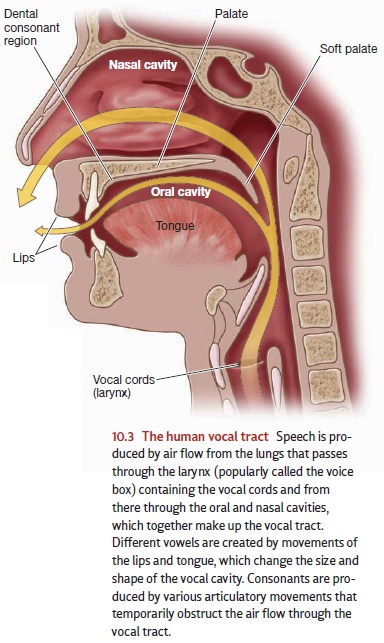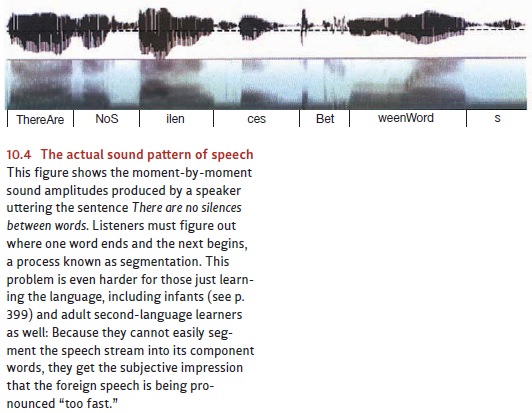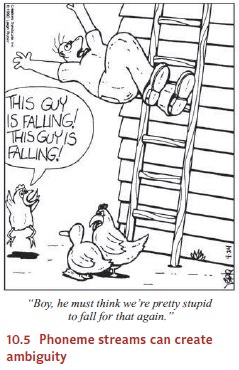Chapter: Psychology: Language
Building Blocks of Language: The Sound Units
The Sound Units
To speak, we force a column of
air up from the lungs and out through the mouth, while simultaneously moving
the various parts of the vocal apparatus from one position to another (Figure
10.3). Each of these movements shapes the column of moving air and thus changes
the sound produced. The human speech apparatus can emit hundreds of different
speech sounds clearly and reliably, but each language makes systematic use of

only a small number of these
physical possibilities. For example, consider the English word bus, which can be pronounced with more
or less of a hiss in the s. This
sound dif- ference, though audible, is irrelevant to the English-language
listener, who interprets what was heard to mean “a large vehicle” in either
case. But some sound distinctions do matter, for they signal differences in
meaning. Thus, neither butt nor fuss will be taken to mean “a large
vehi-cle.” This suggests that the distinctions among s, f, and t sounds are rel-evant to the perception
of English, while the difference in hiss duration is not. The sound categories
that matter in a language are called its phonemes.
English uses about 40 different phonemes.* Other lan-guages select their own
sets. For instance, German uses certain guttural sounds that are never heard in
English, and French uses some vowels that are different from the English ones,
making trouble for Americans who are trying to order le veau or le boeuf in
Parisian restaurants (Ladefoged & Maddieson, 1996; Poeppel & Hackl,
2007).
Not every phoneme sequence occurs
in every language. Sometimes these gaps are accidental. For instance, it just
so happens that there is no English word pilk.
But other gaps are systematic effects of the lan-guage design. As an
illustration, could a new breakfast food be called Pritos? How about Glitos
or Tlitos? Each of these would be a
new word in English, and all can be pronounced, but one seems wrong: Tlitos. English speakers sense that
English words never start with tl,
even though this phoneme sequence is perfectly acceptable in the middle of a
word (as in motley or battling). So the new breakfast food
will be marketed as tasty, crunchy Pritos
or Glitos. Either of these two names
will do, but Tlitos is out of the
question. The restriction againsttlbeginnings
is not a restriction onwhat human tongues and ears can do. For instance, one
Northwest Indian language is named Tlingit, obviously by people who are
perfectly willing to have words begin with tl.
This shows that the restriction is a fact about English specifically. Few of us
are con-scious of this pattern, but we have learned it and similar patterns
exceedingly well, and we honor them in our actual language use.
Languages differ from one another
in several other ways at the level of sound. There are marked differences in
the rhythm in which the successive syllables occur, and


differences as well in the use
and patterning of stress (or accent) and tone (or pitch). For instance, in
languages such as Mandarin Chinese or Igbo, two words that consist of the same
phoneme sequence, but that differ in tone, can mean entirely different things.
Languages also differ in how the phonemes can occur together within syllables.
Some languages, such as Hawaiian and Japanese, regularly alternate a single
consonant with a single vowel. Thus, we can recognize words like Toyota and origami as “sounding Japanese” when they come into common English
usage. In contrast, syllables with two or three consonants at their beginning
and end are common in English; for example, flasks
or strengths.
Speech can be understood at rates
of up to about 250 words per minute. The normal rate is closer to 180 words per
minute, which converts to about 15 phonemes per sec-ond. These phonemes are
usually fired off in a continuous stream, without gaps or silences in between
the words (Figure 10.4). This is true for phonemes within a single word and
also for words within a phrase, so that sometimes it is hard to know whether
one is hearing “that great abbey” versus “that gray tabby” or “The sky is
falling” versus “This guy is falling” (Levelt, 1989; Liberman, Cooper,
Shankweiler, & Studdert-Kennedy, 1967; see Figure 10.5).
Related Topics